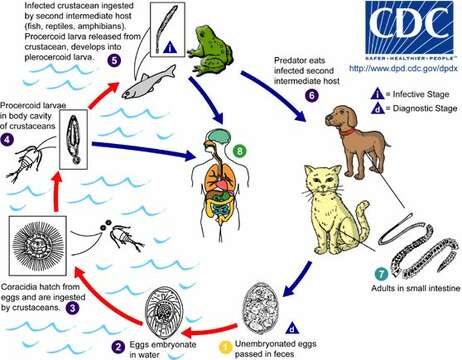Life cycle of Spirometra tapeworms causing sparganosis in humans

Açıklama:
Life cycle of Spirometra tapeworms causing sparganosis in humans
Adult tapeworms in the genus Spirometra live in the intestines of dogs and cats (7). Eggs are shed in feces (1) and embryonate in the environment (2). Eggs hatch in water and release coracidia (3), which are ingested by copepods. The coracidia develop into procercoid larvae in the copepod intermediate host (4). Second intermediate hosts, including fish, reptiles and amphibians, ingest infected copepods and acquire procercoid larvae. The procercoid larvae develop into plerocercoid larvae in the second intermediate host (5). The cycle is completed when a predator (dog or cat) eats an infected second intermediate host (6). Humans cannot serve as definitive hosts for Spirometra spp., but serve as paratenic hosts ("transport hosts") or second intermediate hosts (8) and develop sparganosis. Humans acquire sparganosis by either drinking water contaminated with infected copepods or consuming the flesh of an under-cooked second intermediate or paratenic host. Larvae of these tapeworms (spargana) can live up to 20 years in the human host.
From Centers for Disease Control Parasites and Health website.
Aşağıdaki Sayfalarda Bulunmaktadır:
- Eukaryota (Ökaryot)
- Opisthokonta
- Metazoa
- Bilateria
- Protostomia
- Platyhelminthes (Yassı solucanlar)
- Rhabditophora
- Life
- Cellular
- Spiralia
- Cestoda (Şeritler)
- Diphyllobothriidae
- Spirometra
- Spirometra erinaceieuropaei
Bu resim hiçbir koleksiyonda yer almıyor.
Kaynak Bilgileri
- lisans
- cc-by-nc
- telif hakkı
- Centers for Disease Control/Division of Parasitic Diseases and Malaria
- yayıncı
- Shapiro, Leo
- fotoğrafçı
- Centers for Disease Control/Division of Parasitic Diseases and Malaria
- sağlayıcı
- EOL Rapid Response Team
- orijinal
- orijinal medya dosyası
- kaynağı ziyaret et
- ortak site
- EOL staff
- ID


